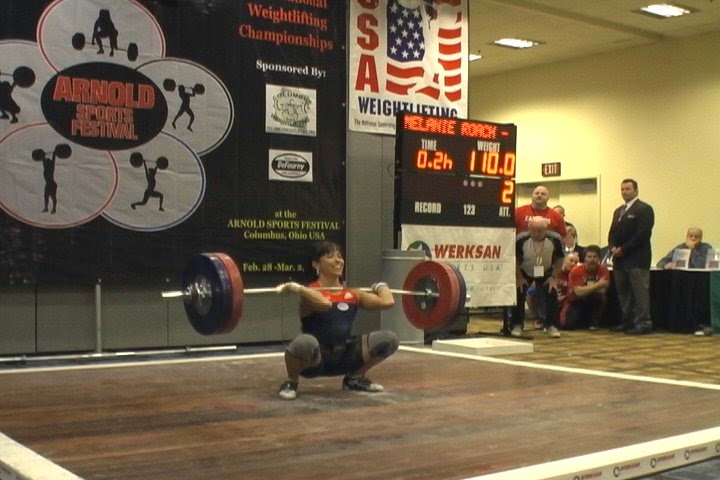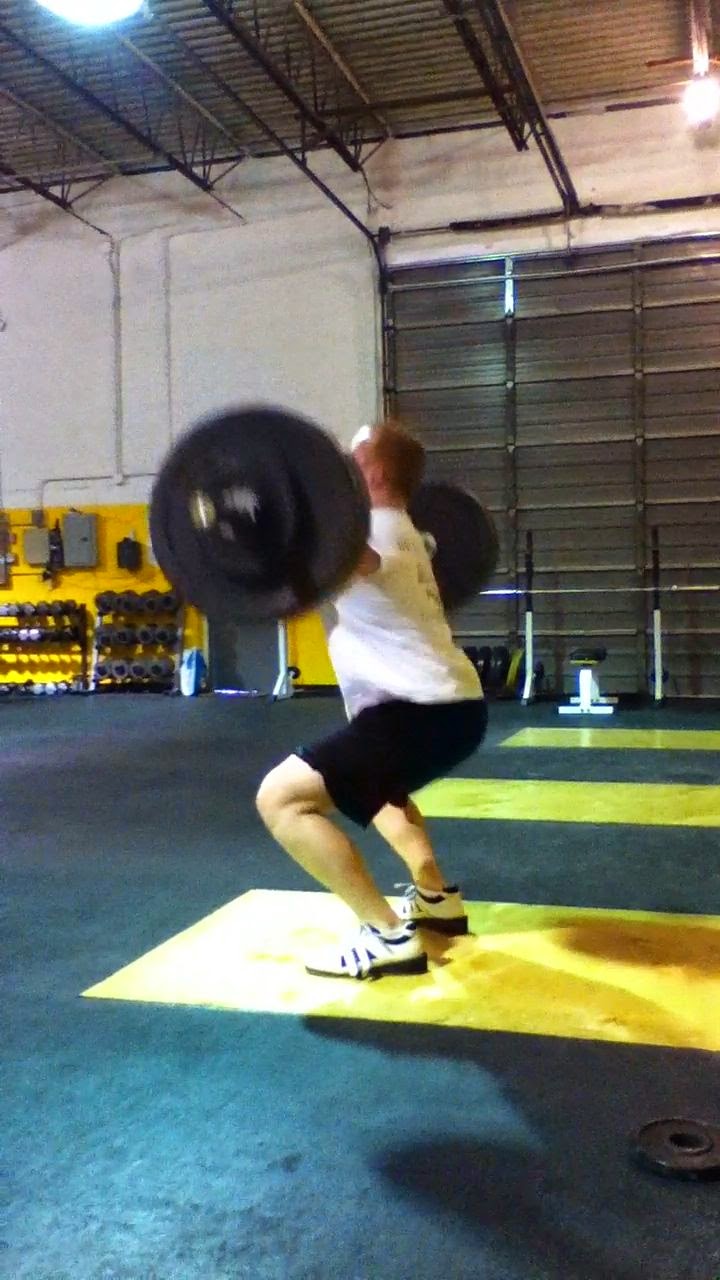Weightlifting Shoes: Do your athletes need them?
 | |
| Current 6' 9" Pepperdine starting MB Mitch Penning front squats 100 kg in high school. |
1. Does the athlete have ankle mobility issues with basic squatting?
2. Are you going to train the full snatch and clean, or lift from the ground on a consistent basis?
If you answer "yes" to either of these questions, you should encourage your athlete to use weightlifting shoes during training sessions, with all barbell movements.
Weightlifters wear these funky, clunky high heeled shoes for two reasons. First, firm soles give the athlete a firm connection to the platform so there is no loss of force when driving the feet into the ground on lift off, recovery from the bottom or the dip and drive of the jerk. Second, heeled soles give the athlete additional ankle dorsiflexion, which allows for optimal vertical torso positioning on lift off and recovery.
 |
| Melanie Roach (53 kg) prepares to stand with 110 kg clean. |
 |
| Natalie Burgener (63 kg) stays vertical as she dips with 115 kg. |
Weightlifting shoes are not crutches or band-aids. They are part of a weightlifter's equipment and uniform. And they can assist young and old non-weightlifting athletes by putting these athletes in better positions when learning to squat or do the full versions of the lifts. They can assist an athlete in learning the importance of ankle mobility when squatting without weightlifting shoes.
I cannot tell you how many times I have had to physically put someone in weightlifting shoes before he or she really believes this and feels the difference. It only takes a few reps before the light bulb comes on. The athlete feels the connection to the platform and senses the better upright position. I had a small stash of shoes at my facility for this purpose and at the USSA Center of Excellence, we keep shoes in the gym so athletes can try them.
If you are a coach who coaches the barbell lifts, you should own a pair of shoes and you should have a good understanding of how these shoes impact mechanics, mobility and leverage in common lifting positions. They are now much easier to find and cost ranges from $70 to $200. VS Athletics and Wei Rui shoes are budget friendly. Adidas has some lower cost shoes now. You can get classic wooden heel shoes in custom colors from Risto Sports. One pair should last a non-weightlifter many, many years.
 |
| Ryan Sexton recovers from a clean in his VS Athletics shoes. |
Have I used them with all of my athletes? The answer is no. Good court shoes and good ankle mobility will work for younger athletes training the basic squats and push press. If the athlete needs and wants to move on, I strongly recommend they invest in a pair of shoes. If you are only doing bodyweight circuits and dumbbell complexes with teams, then no, these athletes don't need weightlifting shoes.
If an athlete is very tall and inflexible, I have used weightlifting shoes to help develop better movement patterns and mobility. Not a crutch, but a tool to provide feedback and guidance.
The best analogy I can give for using weightlifting shoes is using cycling shoes. You can ride a bike for enjoyment with or without cycling shoes. But if you invest in a pair of shoes and learn how to clip in, you will feel the difference it makes in your comfort, power and efficiency. I don't have to be a professional cyclist to benefit from using and investing in pure cycling footwear--or shorts for that matter. But it will make my riding and training much more enjoyable and probably more effective.
If I swim, I wear goggles. If I cross country ski, I wear cross country ski boots and skis. I use tools and equipment from many sports to facilitate my own training and the preparation of my athletes. I teach them the how and why for now and then they can also use this information and equipment to enjoy lifting, biking or whatever after they retire from competition.
 |
| Ryan Sexton demonstrates parallel shin / torso that good ankle dorsiflexion allows. |
Many may disagree with me and that's fine. There is more than one path to any given destination. But if you are teaching the full barbell movements and you are squatting your athletes heavy, you'd better have a clear understanding of your athlete's mobility, the safety of the positions they are in and the loads you are putting them under.

Comments